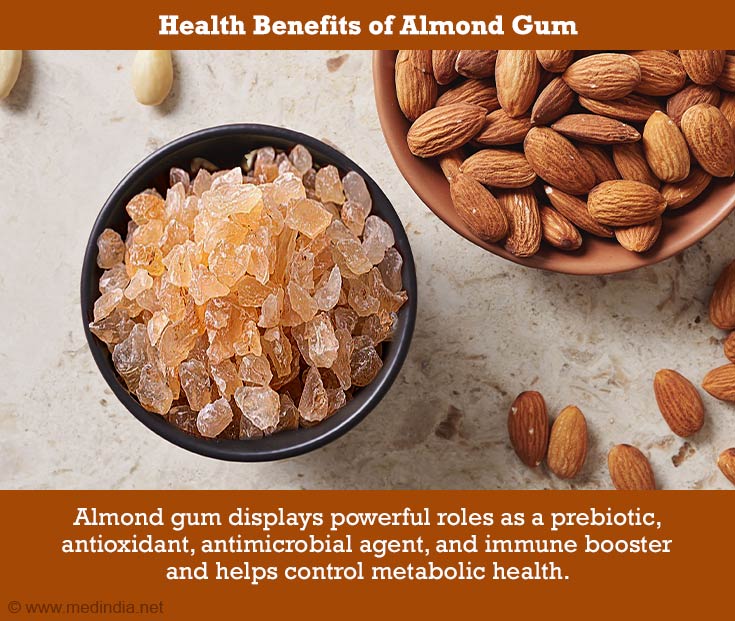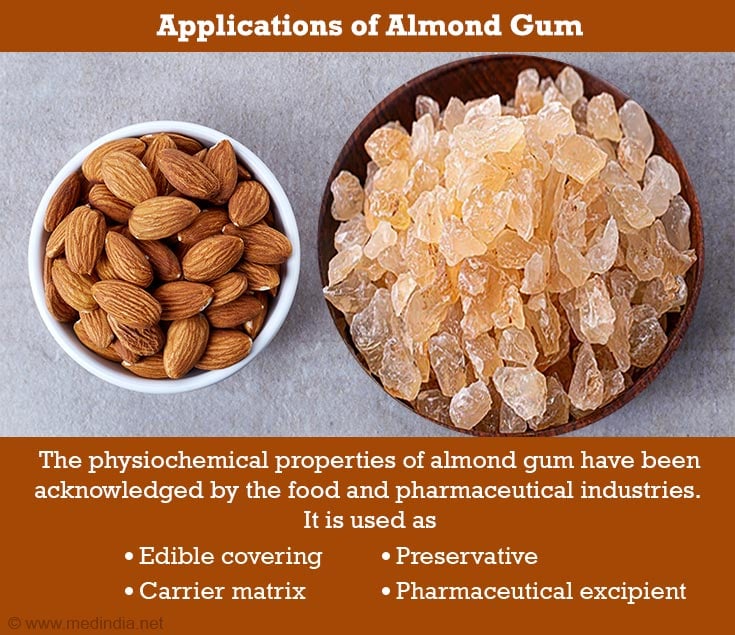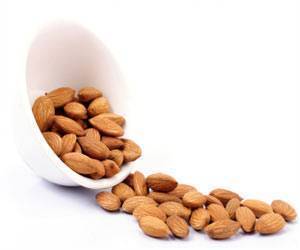- Recently Investigated Natural Gums and Mucilages as Pharmaceutical Excipients: An Overview - (https://doi.org/10.1155/2014/204849)
- Assessment of physical and structural characteristics of almond gum - (https://www.sciencedirect.com/science/article/abs/pii/S0141813016315094)
- Biological properties of water-soluble polysaccharides and hemicelluloses from almond gum - (https://www.sciencedirect.com/science/article/abs/pii/S0141813016315331?via%3Dihub)
- Almond By-Products: Valorization for Sustainability and Competitiveness of the Industry - (https://www.mdpi.com/2304-8158/10/8/1793)
- The stabilizing and prebiotic potential of water-soluble phase of bitter almond gum exudate in probiotic yogurt drink - (https://linkinghub.elsevier.com/retrieve/pii/S014486172031568X)
- The effect of Plantago major seed and Almond gum on refractory asthma: A proof-of-concept study - (https://www.sciencedirect.com/science/article/abs/pii/S2210803319300442?via%3Dihub)
- Bitter almond gum reduces body mass index, serum triglyceride, hyperinsulinemia and insulin resistance in overweight subjects with hyperlipidemia - (https://www.sciencedirect.com/science/article/abs/pii/S1756464619301021?via%3Dihub)
- The effect of bitter almond (Amygdalus communis L. var. Amara) gum as a functional food on metabolic profile, inflammatory markers, and mental health in type 2 diabetes women: a blinded randomized controlled trial protocol - (https://trialsjournal.biomedcentral.com/articles/10.1186/s13063-023-07085-7)
- Formulation and characterization of natural almond gum as an edible coating source for enhancing the shelf life of fresh cut pineapple slices - (https://www.sciencedirect.com/science/article/pii/S2772753X23001880?via%3Dihub)
- Use of Almond Gum and Gum Arabic as Novel Edible Coating to Delay Postharvest Ripening and to Maintain Sweet Cherry (Prunus avium) Quality during Storage - (https://ifst.onlinelibrary.wiley.com/doi/10.1111/jfpp.12369)
- Formulation of a probiotic product using Almond gum - (https://onlinelibrary.wiley.com/doi/10.1002/jsfa.13301)
- Structural data and biological properties of almond gum oligosaccharide: Application to beef meat preservation - (https://www.sciencedirect.com/science/article/abs/pii/S0141813014005881?via%3Dihub)
- Extraction and Characterization of Almond (Prunus sulcis) Gum as Pharmaceutical Excipient - (https://www.idosi.org/aejaes/jaes14(3)14/14.pdf)
About
Edible gums derived from plants or natural sources have piqued a great interest in recent years. Almond gum has been investigated by many researchers to describe its benefits for diabetes, weight loss, intestinal health, and more.
What is Almond Gum?
Almond gum, obtained from the tree and shrubs of Prunus amygdalus, exhibits several vital components that deliver benefits to health. The gum is generally pale yellow to amber-brown in color. Also known as Badam pisin or Badam gum, it is well-known for its functionality in the food and pharmaceutical industries. The gum is extracted by producing mechanical injury to the tree, followed by microbial treatment.
Natural forms of gum are highly preferred for their biocompatibility, biodegradability, sustainability, eco-friendliness, and cost-efficiency. Gums are classified based on their source, such as marine origin (such as agar, alginic acid), plant origin (such as guar gum, almond gum, gum arabic, and larch gum), animal origin, and microbial origin (such as xanthan, dextran, and emulsan)(1✔ ✔Trusted Source
Recently Investigated Natural Gums and Mucilages as Pharmaceutical Excipients: An Overview
Go to source, 2✔ ✔Trusted Source
Assessment of physical and structural characteristics of almond gum
Go to source).
What are the Health Benefits of Almond Gum?
- Antioxidant actions: Almond gum’s polysaccharides and hemicellulose were studied to reveal their antioxidant activities. Studies have found interesting free radical scavenging activities by both polymers through radical scavenging activity tests, DPPH tests, and more(3✔ ✔Trusted Source
Biological properties of water-soluble polysaccharides and hemicelluloses from almond gum
Go to source). - Antibacterial benefits: A study that evaluated the antimicrobial mechanisms of almond gum on pathogenic strains found that it efficiently inhibited bacterial growth. It has exhibited antibacterial activities against Escherichia coli, Salmonella paratyphi, and Staphylococcus aureus and antifungal properties against Candida albicans.
The polysaccharides present in badam pisin acted as effective bacteriostatic compounds against S. aureus, P. aeruginosa, E. coli, E. faecalis, and S. Typhimurium. Whereas the hemicellulose present in badam pisin had high antibacterial activity against gram-positive bacteria like Bacillus subtilis, Actinomyces sp., and S. aureus, and gram-negative bacteria like Salmonella typhi and Klebsiella pneumoniae(2✔ ✔Trusted Source
Assessment of physical and structural characteristics of almond gum
Go to source, 4✔ ✔Trusted Source
Almond By-Products: Valorization for Sustainability and Competitiveness of the Industry
Go to source).
- Prebiotic properties: A studyevaluated the prebiotic effect of the soluble fraction of bitter almond gum on the stability and viability of a probiotic yogurt Adding almond gum along with locust bean gum helped stabilize the yogurt drink and maintain the viability of Lactobacillus acidophilus.(5✔ ✔Trusted Source
The stabilizing and prebiotic potential of water-soluble phase of bitter almond gum exudate in probiotic yogurt drink
Go to source)

- Eases respiratory problems: A study found that administering a herbal combination containing 3g of almond gum powder and 2g of Plantago major (plantain), thrice a day for four weeks helped relieve wheezing, cough, dyspnea, and improved sleep quality among patients with refractory asthma. However, the effect of administering almond gum alone is not known. The formulation may act as a demulcent that protects and soothes the irritated surfaces of the gastrointestinal and respiratory tracts. The hydro-soluble fibers present may also help increase the thickness of the diffusion barrier in the intestine(6✔ ✔Trusted Source
The effect of Plantago major seed and Almond gum on refractory asthma: A proof-of-concept study
Go to source). - Improves metabolic profile: Almond gum appears to be effective in weight management. In a study, patients with hyperlipidemia were given apple juice enriched with bitter almond gum for six weeks. At the end of the intervention, significant reductions in body weight and BMI were observed(7✔ ✔Trusted Source
Bitter almond gum reduces body mass index, serum triglyceride, hyperinsulinemia and insulin resistance in overweight subjects with hyperlipidemia
Go to source). - Controls cholesterol levels: Badam pisin acts as a functional food in managing lipid profile. The flavonoids and phenolic acids in badam pisin may activate genes that encode lipoprotein lipase and apo C-II oxidation. These mechanisms play crucial roles in reducing cholesterol levels. Studies have shown positive correlations between almond gum supplementation and a reduction in serum triglycerides(7✔ ✔Trusted Source
Bitter almond gum reduces body mass index, serum triglyceride, hyperinsulinemia and insulin resistance in overweight subjects with hyperlipidemia
Go to source, 8✔ ✔Trusted Source
The effect of bitter almond (Amygdalus communis L. var. Amara) gum as a functional food on metabolic profile, inflammatory markers, and mental health in type 2 diabetes women: a blinded randomized controlled trial protocol
Go to source). - Helps manage diabetes: A study showed that consuming bitter almond gum helps increase GLP-1 production, which aids in improved glucose tolerance. The fiber and prebiotic effectsof badam pisin, along with other nutrients, may turn down insulin resistance and insulin concentrations, thereby controlling blood glucose levels(7✔ ✔Trusted Source
Bitter almond gum reduces body mass index, serum triglyceride, hyperinsulinemia and insulin resistance in overweight subjects with hyperlipidemia
Go to source, 8✔ ✔Trusted Source
The effect of bitter almond (Amygdalus communis L. var. Amara) gum as a functional food on metabolic profile, inflammatory markers, and mental health in type 2 diabetes women: a blinded randomized controlled trial protocol
Go to source). - Strengthens immune system: The prebiotic properties exhibited by the bitter almond gum favorably act on the immune system. The polysaccharides in almond gum may help reduce inflammation by producing anti-inflammatory compounds, thereby strengthening immunity(8✔ ✔Trusted Source
The effect of bitter almond (Amygdalus communis L. var. Amara) gum as a functional food on metabolic profile, inflammatory markers, and mental health in type 2 diabetes women: a blinded randomized controlled trial protocol
Go to source).
What are the Uses of Almond Gum?
Almond gum also exhibits properties such as a thickener, emulsifier, suspender, glazer, stabilizer, and adhesive. The space below discusses some of its uses in various fields(1✔ ✔Trusted Source
Recently Investigated Natural Gums and Mucilages as Pharmaceutical Excipients: An Overview
Go to source).
- Edible covering: Almond gum has excellent flowing properties and good emulsion stability. A study analyzed the physiochemical properties of natural badam pisin exudates as a coating to extend the shelf life of pineapple. Compared to synthetic gum coating, almond gum delayed changes in the weight loss, color, hardness, microbial growth, and titratable acidity of pineapple, thus increasing its shelf life. Another study showed that sweet cherries coated with 10% almond gum enhanced the fruit’s shelf life and postharvest quality(9✔ ✔Trusted Source
Formulation and characterization of natural almond gum as an edible coating source for enhancing the shelf life of fresh cut pineapple slices
Go to source, 10✔ ✔Trusted Source
Use of Almond Gum and Gum Arabic as Novel Edible Coating to Delay Postharvest Ripening and to Maintain Sweet Cherry (Prunus avium) Quality during Storage
Go to source). - Carrier matrix for probiotic products: Badam pisin acts as a promising carrier matrix for formulating probiotic products. Almond gum was found to possess high entrapment efficiency and viability for changing pH. Its carbohydrates also serve as a prebiotic. Another study that formulated a probiotic yogurt drink with bitter almond gum found that it prevented phase separation for a longer time. It also helped in keeping Lactobacillus acidophilus viable(5✔ ✔Trusted Source
The stabilizing and prebiotic potential of water-soluble phase of bitter almond gum exudate in probiotic yogurt drink
Go to source, 11✔ ✔Trusted Source
Formulation of a probiotic product using Almond gum
Go to source) - Preservative: The antibacterial and antioxidant effects of almond gum serve as a potential preservative for meat products. Almond gum has shown significant inhibitions of microbial growth and lipid oxidation in ground beef meat(12✔ ✔Trusted Source
Structural data and biological properties of almond gum oligosaccharide: Application to beef meat preservation
Go to source). - Pharmaceutical excipient: Owing to its solubility in water, excellent flowing properties, good swelling index, and other organoleptic properties, almond gum is portrayed as a pharmaceutical excipient for formulating solid oral dosage forms(13✔ ✔Trusted Source
Extraction and Characterization of Almond (Prunus sulcis) Gum as Pharmaceutical Excipient
Go to source).

Nutritional Facts
Badam pisin’s nutritional profile consists of beneficial minerals and macronutrients. On a dry weight basis, it contains 92.36% carbohydrates, 2.45% proteins, and 0.85% fats. The almond gum’s carbohydrate composition comprises galactose (35.49%), arabinose (46.83%), uronic acid (5.97%), and traces of mannose, xylose, rhamnose, and glucose. Minerals like potassium, sodium, calcium, magnesium, and iron are also present in almond gum.
Must Try Recipes
Badam pisin is commonly used in making sweets, drinks, laddu, and more. Here are some delicious recipes one can try with almond gum(2✔ ✔Trusted Source
Assessment of physical and structural characteristics of almond gum
Go to source).
Badam Pisin laddu
Ingredients:
- Badam Pisin - ¼ cup
- Grated coconut - ¼ cup
- Almonds- ¼ cup
- Cashew - ¼ cup
- Fox nuts - ½ cup
- Melon seeds - ¼ cup
- Poppy seeds - ¼ cup
- Raisins - 1 tbsp
- Ghee – ¾ cup
- Jaggery - ¾ cup
- Wheat flour – 1¼ cup
- Besan flour- 1 tbsp
- Dry ginger powder - 1 tsp
- Cardamom powder - ½ tsp
- Salt- a pinch
Preparation:
- Shallow fry the badam pisin in a little ghee on low heat and let it cool.
- Similarly, fry each ingredient with a little ghee. Wheat flour should be roasted until it changes color.
- In a pan, add water, jaggery, cardamom, and dry ginger powder, and set it on low heat. Let the jaggery melt and boil.
- Meanwhile, crush the roasted almond gum and nuts using the bottom of a ladle or a bowl. Add all the ingredients together in a bowl, and add it coconut gratings, flour, and seeds.
- Filter the jaggery mix, add to the bowl, and mix well.
- Roll out the mixture into small balls and serve.
Jigarthanda Drink
Ingredients:
- Badam Pisin- 1 tsp
- Water- 1 cup
- Milk- 1 cup
- Condensed milk- 2 tbsp
- Nannari or rose syrup- 2 tsp
- Ice cream of choice- 1 scoop
Preparation:
- Rinse the badam pisin in water and soak it in water overnight. It increases in volume and becomes jelly-like.
- In a small bowl, add condensed milk, chilled milk and whisk well. Refrigerate in the fridge for some time.
- In a glass, add the soaked badam pisin, nannari syrup, and the milk mixture.
- Top it with a scoop of ice cream.
- Drizzle with some more syrup. Top it with dry fruits and nuts, if preferred.
- Serve immediately.








